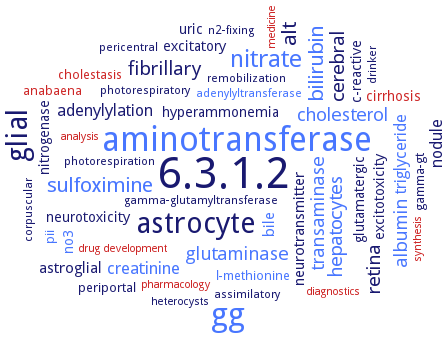6.3.1.2: glutamine synthetase
This is an abbreviated version!
For detailed information about glutamine synthetase, go to the full flat file.

Word Map on EC 6.3.1.2 
-
6.3.1.2
-
aminotransferase
-
gg
-
glial
-
astrocyte
-
nitrate
-
bilirubin
-
sulfoximine
-
alt
-
cerebral
-
hepatocytes
-
retina
-
fibrillary
-
cholesterol
-
glutaminase
-
albumin
-
transaminase
-
creatinine
-
adenylylation
-
triglyceride
-
nodule
-
astroglial
-
bile
-
neurotransmitter
-
excitatory
-
c-reactive
-
uric
-
no3
-
neurotoxicity
-
glutamatergic
-
nitrogenase
-
hyperammonemia
-
excitotoxicity
-
cirrhosis
-
l-methionine
-
anabaena
-
periportal
-
pii
-
cholestasis
-
gamma-gt
-
photorespiratory
-
n2-fixing
-
pericentral
-
gamma-glutamyltransferase
-
photorespiration
-
corpuscular
-
adenylyltransferase
-
drinker
-
assimilatory
-
remobilization
-
drug development
-
synthesis
-
pharmacology
-
diagnostics
-
heterocysts
-
medicine
-
analysis
- 6.3.1.2
- aminotransferase
- gg
- glial
- astrocyte
- nitrate
- bilirubin
- sulfoximine
-
alt
- cerebral
- hepatocytes
- retina
-
fibrillary
- cholesterol
- glutaminase
- albumin
- transaminase
- creatinine
-
adenylylation
- triglyceride
- nodule
-
astroglial
- bile
-
neurotransmitter
-
excitatory
-
c-reactive
-
uric
- no3
-
neurotoxicity
-
glutamatergic
- nitrogenase
-
hyperammonemia
-
excitotoxicity
- cirrhosis
- l-methionine
- anabaena
-
periportal
- pii
- cholestasis
- gamma-gt
-
photorespiratory
-
n2-fixing
-
pericentral
- gamma-glutamyltransferase
-
photorespiration
-
corpuscular
- adenylyltransferase
-
drinker
-
assimilatory
-
remobilization
- drug development
- synthesis
- pharmacology
- diagnostics
- heterocysts
- medicine
- analysis
Reaction
Synonyms
AmGLN1, ATP glutamate-ammonia ligase, Chloroplast GS2, Clone lambda-GS28, Clone lambda-GS31, Clone lambda-GS8, Cytoplasmic GS3, Cytosolic GS1, gamma-glutamyl transferase, gamma-glutamyl:ammonia ligase, gamma-glutamylhydroxamate synthetase, Gln isozyme alpha, Gln isozyme beta, Gln isozyme gamma, Gln synthetase, GLN1,1, GLN1,2, GLN1,3, GLN1,4, GLN1-1, GLN1-2, Gln1;1, Gln1;2, Gln1;3, Gln1;4, Gln1;5, GLN2, GlnA, glnA-1, GlnA1, GlnA2, GlnA3, GlnA4, GlnN, GlnR, GluA, GLUL, Glutamate--ammonia ligase, glutamate-ammonia ligase, Glutamine synthetase, glutamine synthetase cytosolic isozyme 1, glutamine synthetase cytosolic isozyme 2, glutamine synthetase I, glutamine synthetase type II, glutamine synthetase type III, Glutamylhydroxamic synthetase, GS, GS type I, GS type-1, GS(1), GS-II, GS1, GS1 kinase, GS1-1, GS1-2, GS107, GS112, GS117, GS12, GS122, GS1a, GS1beta1, GS1gamma1, GS2, GS2a, GS3, GSI, GSII, GSIII, Isozyme delta, L-glutamate:ammonia ligase, L-glutamate:ammonia ligase (ADP-forming), L-Glutamine synthetase, LDBPK_060370, LdGS, MM_0964, MtGS, N47/N48, OsGLN1,1, OsGLN1,2, protein transacetylase, S2205/S2287, SSO0366, Synthetase, glutamine, TAase, type I glutamine synthetase, type III glutamine synthetase


 results (
results ( results (
results ( top
top





